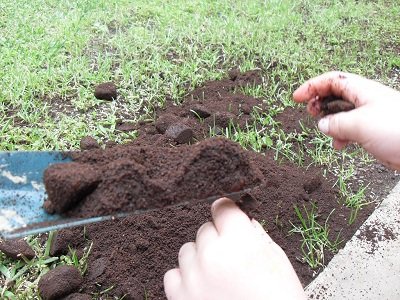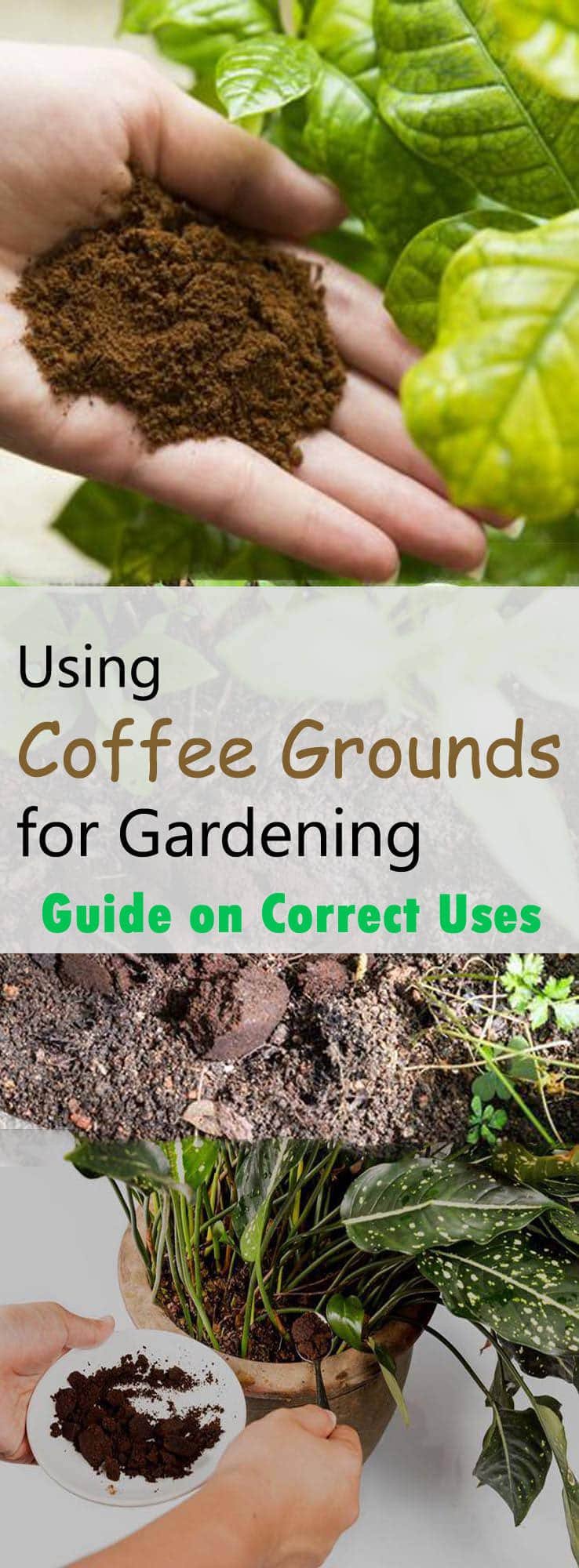Using coffee grounds for gardening really helps! Know all about the correct ways to use coffee grounds in the garden by reading this educative article.

Coffee Grounds as Fertilizer
Coffee grounds contain 2% of nitrogen, but plants can not use this until it breaks down. As these grounds decompose, the low nitrogen level in them acts as a long-acting fertilizer.
Coffee grounds also provide a healthy and slight dose of other basic nutrients like phosphorus and potassium. They also contain small quantity calcium, manganese, zinc, and iron. You can sprinkle coffee grounds directly onto the soil or
Coffee Grounds in Soil

But who cares about the acidity, coffee grounds improve soil structure directly and in no time. Poor Soil, low in organic matter benefits greatly when amended coffee grounds.
By adding organic matter to the soil, they improve drainage, water retention, and aeration of the soil. Coffee grounds in the soil also improve the seed germination and growth of the plant. What is more advantageous is that they prevent soil-borne diseases like wilts, fungal rots, and some bacterial pathogens.
Coffee Grounds as Compost
If you’re about to add coffee grounds to your compost piles, restrict it to the range of 20 to 25 percent only. Higher levels than this can suppress beneficial microorganisms, so don’t overdo it. Balance your compost with other organic materials such as residue of grass clippings, dry leaves, woody prunings newspaper, or similar composting materials. You can also add it to worm bins as they love coffee grounds.
Coffee Grounds for Mulching
Coffee ground mulching is becoming popular because of the claims that they deter pets, obstruct weeds, and aerate the soil. But as coffee grounds have a fine texture, their use as mulch works best only in combination with coarse organic mulches. When used purely without mixing them with other organic matter, they can cause more harm than good. Instead of keeping the soil, moist, coffee grounds will dry out the soil more quickly. Some organic materials you can use with coffee grounds are dry leaves, compost, barks, and twigs. They enhance the mulch and negate the effect of using coffee grounds alone.
NOTE: In case of a shortage of coffee grounds, ask any nearby coffee store, and you might get them for free.
Also Read: Epsom salt uses in garden
Coffee Ground as Pesticide
Many gardeners believe that slugs and snails tend to steer clear of the regions treated with coffee grounds. It’s due to the popular belief that coffee growing repels slugs and snails and other pests. Some believe that the abrasive texture of coffee grounds is something slugs can’t go through due to their soft-bodies. Although there is no proof of such claims, many gardeners still use coffee grounds as fertilizer. You can try it out and see if it works for yourself. Let us know in the comments section!




I’ve read many references about using coffee grounds, and virtually all say to use only thin layers. Well, I’ve been gradually increasing the amount I apply at a time, and I’m finding no harm from putting down layers up to six inches deep.
What happens when I do this? Well, there’s a certain odd fly that seems very attracted to the scent of the fresh grounds, and they also lay eggs in it. The larvae are unseen except after a heavy rain, when they jump around on the surface. But no matter — they’re turning the grounds into fertilizer. And the flies themselves are like candy for the local birds, which are always hunting in my garden.
As to the grounds drying and blocking water, well, this is only partly true. Yes, they will dry to a sort of crust. But if you apply a thick layer, that crust breaks and forms cracks, and water drains right through down to the soil below. When I water with the hose, puddles don’t form — water goes straight down, as if I mulched with gravel. Below the layer of coffee grounds the soil stays moist for a long time. And it’s teeming with earthworms and other organisms.
I collect a garbage can full of used coffee grounds from Starbucks every day. I bought two cans, left one there, and returned the next day to swap them out. I dump the can into a wheelbarrow to pull out the filters — which go into the compost heap — and scoop the grounds into a bucket to carry to where the garden needs some. I keep going until there’s snow covering the garden, and resume when it melts in late Winter. It takes me about 3-4 months to make the rounds through the whole garden, and then I go back and start at the beginning again. My beds are raised, but I filled them with composted shredded tree mulch as a base rather than topsoil. And then I started collecting the coffee grounds to fill as the mulch settled and broke down.
Thank you for your valuable comment.
That was good advice, I also collect coffee grounds from Star Bucks! Are you on facebook? I would like to see you garden!
Will begin working on the back yard next spring and am wondering if I can scatter coffee grounds into the yard to improve the soil?
Yes, coffee grounds will definitely improve your soil structure.
I thought I heard that they are good as an organic slug repellent .if you scatter them around the plants.is this true?
Slugs did not like them so around your Hosta’s would be good.
Protect your Hostas with Costa’s 😂
Thank you for sharing what to do whith the coffee grounds.
Is perked coffee good for plants as well
Is coffee a good cat deterrent in a flower garden
How do I store leftover coffee grounds that I got from Starbucks. They gave me more than I could use for the time being. Maybe the refrigerator?
Compost Pile, Coffee grounds are better if composted as noted in the beginning of the article. They also repel rats and other pests that will scavenge your compost pile for food scraps. Will repel moles that will eat your worms. Feed the worms and they will produce worm castings, another super soil amendment. Worms in your compost pile is a sure sign of a successful compost pile!
thank you. Eric, this was some great info
Do they help repel deer? Trouble with deer and flowers.
Do the repel ants, deer, and squirrels.
I have some old coffee (unbrewed) that I have kept around for guests, but I’m thinking of using it for the garden and replacing the guest coffee with something fresher when needed, as I’m not much of a coffee drinker. I’m wondering if I could just use the unused coffee grounds sprinkled over my wood chip mulch…or would it be better to mix it into my compost pile? Your thoughts?
I was told that coffe grounds are toxic to cats & dogs is this true?
Fresh coffee grounds still have most of their caffeine content as well as the acid. Don t use coffee grounds on seedlings or very young plants, as caffeine can stunt their growth. Be cautious in using fresh grounds around pets or your wire terrier may become extremely wired.
I’ve been using coffee grounds in my garden for a while now, and the results have been fantastic! Not only do they add a natural source of nitrogen to the soil, which my plants love, but they also seem to deter some pests. I’ve noticed fewer issues with snails and slugs since incorporating coffee grounds into my gardening routine.
Another plus is that it’s an eco-friendly way to repurpose something that would otherwise go to waste. So, it’s a win-win – my plants thrive, and I reduce my kitchen waste. Plus, there’s something satisfying about giving your plants a little caffeine boost, just like we enjoy in the morning!
I highly recommend giving coffee grounds a try in your garden. Just remember not to overdo it, as too much coffee can make the soil acidic. Thanks for the helpful tips in your article!